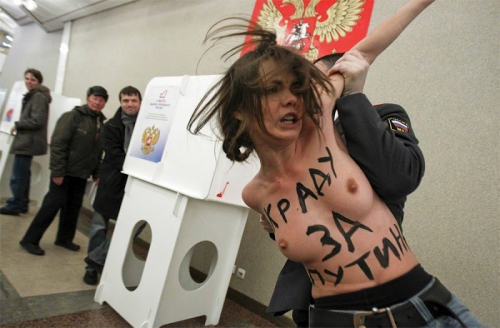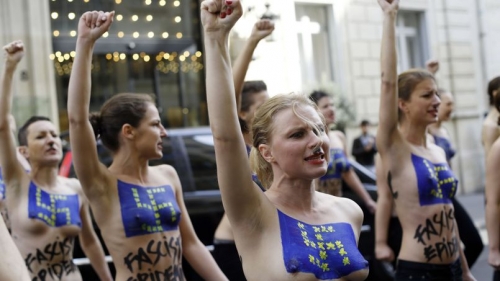Cults are often nasty things that subordinate the free will of their neighbors to all sorts of preposterous and outrageous notions. They are the breeding grounds of political and religious extremism and intolerance. They splinter societies and turn relatives, friends and neighbors against each other. Governments periodically find it necessary to suppress them, even resorting to violence—all the way to actually destroying them with fire, as happened with the Branch Davidians in Waco, Texas on 19 of April 1993. Cults that combine politics with religion, such as the Wahhabi state cult of Saudi Arabia that has been breeding extremism all over the world, are particularly nasty.
But the type of cult I want to discuss is quite different from these.
In fact, it is not even commonly perceived as a type of cult. Its main focus is the construction of Cathedrals of Hate centered on political figureheads. By means of public hate, these figureheads are transformed into deities—demons, to be exact.
Hate is one specific type of emotion; love is another. But all strong emotions are of a kind. Essentially, they are chemical imbalances within the brain that cause us to lose self-control and to act irrationally. Because they are chemically rather than electrically based, they are never fleeting, like thoughts can be, but arise over time and take time to dissipate. And they are all of a kind: we could be variously infatuated or enraged, and love can turn to hate rather suddenly, laying bare the chemical similarity between these two opposite emotions. Individually, privately experienced emotions are inevitable, spontaneous expressions of our animal natures, and the best we can do is sublimate them through art or, failing that, try to repress them. But public emotions, such as rage expressed by large groups, are far from inevitable. They are also far from spontaneous.

Please forgive me for pointing out something glaringly obvious. None of the individuals mentioned in the preceding paragraph, whether dead or alive, is, has ever been or will ever be your girlfriend or your boyfriend. No matter what you do or don’t do, you are not going to either bed or get raped by any of them. The most you’ll ever manage, with one or two of them, is to shake his hand under the watchful eye of his bodyguards, or maybe ask him a polite question at a press conference, and even that would only be possible if you are one of the carefully screened few who are allowed near him. And whatever it is that happens to you, none of them will ever be held personally responsible because of a certain legal principle called raîson d’État that grants them dispensation from human moral norms.
But what you can do is jump up and down and shout obscenities about them with likeminded others, or stand around with signs declaring them to be criminals (or whatever else), or accessorize yourself with hate paraphernalia. Walking around St. Petersburg recently, I saw a fat slob digging around in garbage bins near Sennaya Square while sporting a t-shirt emblazoned with “ПУТИН Х**ЛО”; let a Russian friend translate that for you if you are curious. If you don’t wish to be a socially active worshiper at a Cathedral of Hate, you can stay home and seethe with hatred there, annoying your friends and relatives while marinating your brain in the vitriol of strong political sentiment. You’d think that I’ve seen just about everything by now, but even I have been amazed recently by some perfectly intelligent and otherwise clear-thinking people expressing strong emotions about political figureheads that are, by their very nature, unworthy of any emotions whatsoever—good or bad.
Let me explain why it is that political figureheads are by their nature unworthy of any emotions whatsoever.
We live in a world dominated by machines. Agricultural machines produce our food; industrial machines produce out shelter, clothing and tools; various other types of plant and equipment keep us warm or cool, watered and safe and allow us to move about the landscape (generally in triangular patterns between home, work and shopping). And keeping all of this machinery functioning are social machines. These are unlike all the other machines, which consist mostly of hardware or software, because the moving parts of social machines are composed of meatware—human meatware, to be exact. Human meatware is composed of humans that act like robots.

“A social machine is a form of organization that subordinates the will of the participants to an explicit, written set of rules, that is controlled based on objective, measurable criteria, and that excludes, to the largest extent possible, individual judgment, intuition and independent, spontaneous action. In the process, it becomes blind to all the things that cannot be measured, such as meaning, beauty, happiness, justice and compassion.” [p. 189]
Lest you think that social machines are some sort of pathological aberration, perish the thought! They are perfectly normal for all human societies beyond a certain scale:
“The progression from a humanistic organization that functions on the basis of common understanding, spontaneous cooperation, shared values and individual judgment and initiative to a social machine in which people behave like robots, is automatic: it is simply a question of scale.” [p. 190]
Essentially, humanistic organizations don’t scale. Thus, it is pointless to either like or dislike social machines; their existence is simply a fact that you have to accept and learn to cope with as best you can. You can perhaps opt out of them, based on your own individual likes and dislikes.
For instance, if you dislike industrial agriculture with its chemically poisoned fields, rows upon rows of plastic greenhouses, inhumane factory farms and all the rest, then you can take up homesteading. Then, instead of spending your days sitting in an air-conditioned office looking at a screen you would spend them walking slowly while looking at the rear end of a draft horse, or working a pitchfork while your children grope around in the dirt looking for potatoes to throw in a bucket (as we were doing a couple of weeks ago). But no matter what you do, there will still be social machines, and you will still have to deal with them.
Next, we have to accept that social machines are to a large extent staffed and almost exclusively run by psychopaths:
“…What to a healthy society looks like a terrible character flaw appears perfectly normal, even laudable, in the context of a social machine. Lack of empathy is seen as cool, professional detachment; a psychopath would never let emotion cloud her judgment. Sadistic tendencies (psychopaths hurt people in order to make themselves feel something) are perceived as signs of an incorruptible nature: the rules are the rules! … Because of this, social machines act as psychopath incubators. Psychopaths are not the healthiest of specimens, but because of their greater inclusive fitness within social machines, psychopaths tend to persist and thrive within them while non-psychopaths do not.” [p. 194]
The fact that within social machines psychopaths rise to the top is easy to grasp:
“If having some psychopathic tendencies is helpful for fitting in within a social machine, having more psychopathic tendencies is even more helpful. Consequently, within social machines, pure psychopaths rise through the ranks and concentrate at the top. It should be entirely unsurprising, then, that when we look at the upper echelons of business and government—the C-suite, the boards of directors, the executive branches, the legislatures and the courts—we find that they are pretty much stocked with total psychopaths.” [p. 195]






 del.icio.us
del.icio.us
 Digg
Digg
Les commentaires sont fermés.